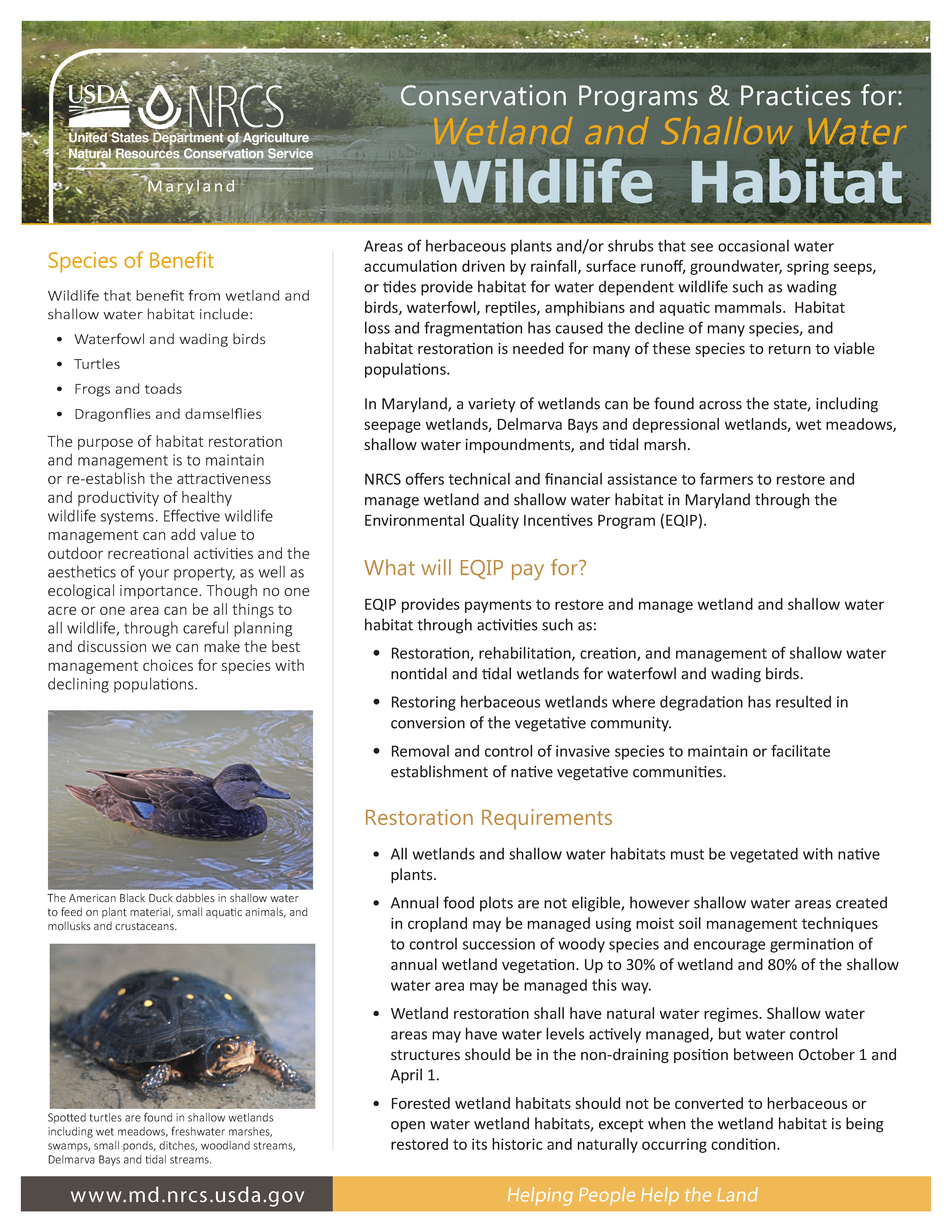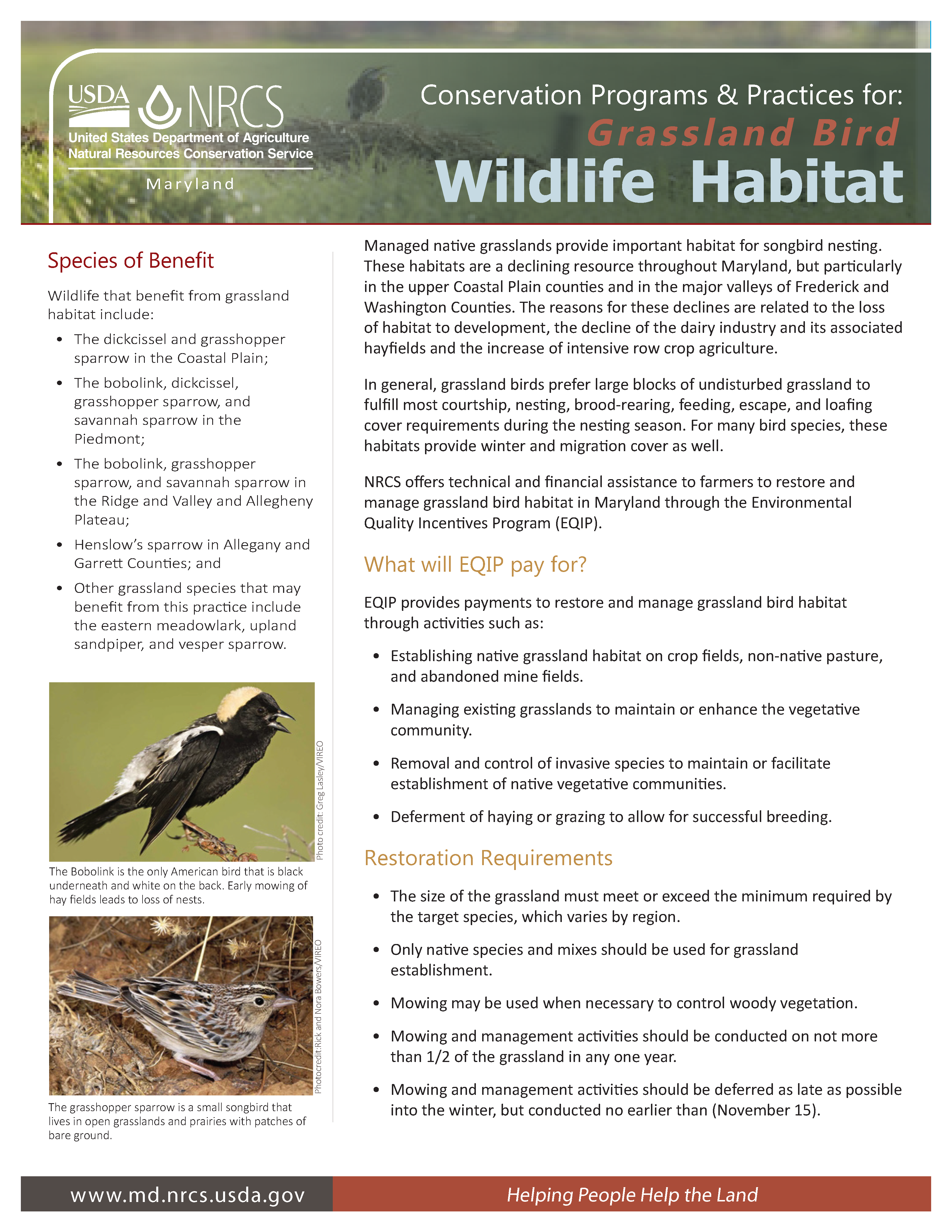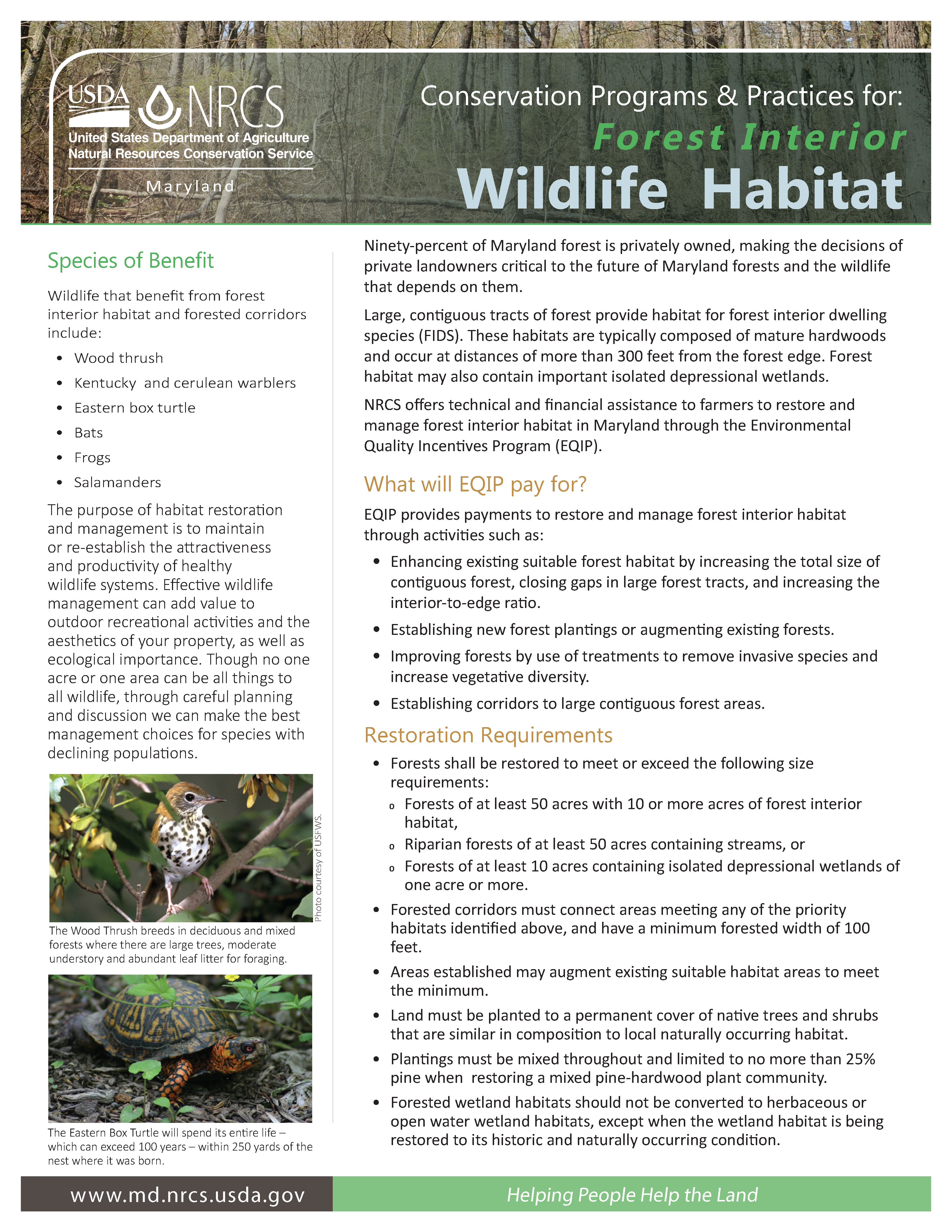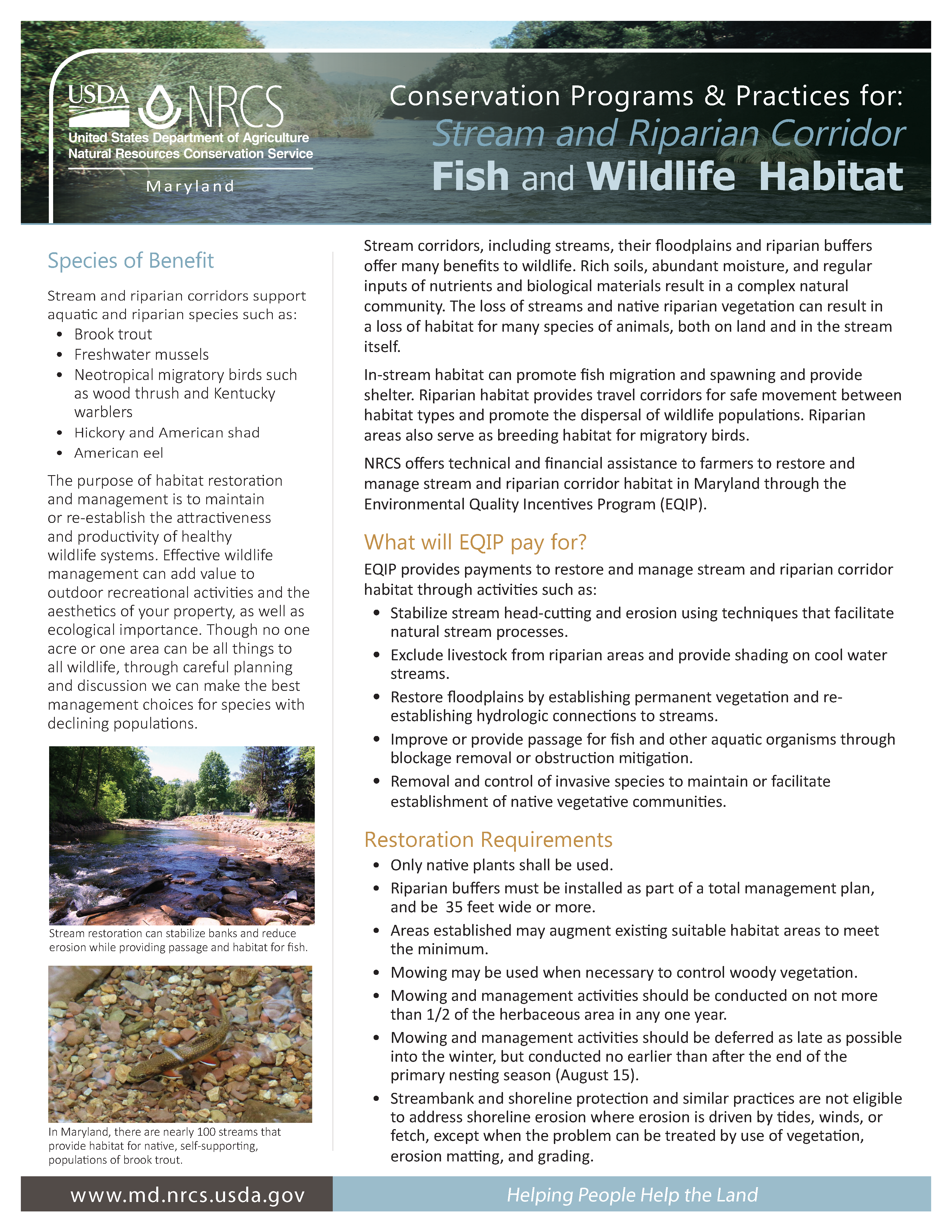Conservation Practices Virtual Education Series: Natural Resources Conservation Service
The Natural Resources Conservation Service (NRCS) is a division of the US Department of Agriculture (USDA) with the mission of helping people help the land. The assistance offered by NRCS can take a variety of forms, from technical assistance to financial assistance for farmers and landowners to help them install practices and operate their land in a more sustainable way.
On the Eastern Shore, some of their most popular practices are wildlife practices, which includes hedgerow plantings, oyster restoration, and pollinator plantings. NRCS also offers assistance with structural practices, such as waste storage structures for manure. Other practices include cover cropping, which is offered through the Regional Conservation Partnership program, as well as their Agricultural Management Assistant program (AMA), a program that typically handles high tunnels and irrigation.

NRCS also takes on projects of CRP (Conservation Reserve Program) and CREP (Conservation Reserve Enhancement Program), both of which are technically FSA programs. NRCS is the technical lead for the project, while FSA focuses on the financial and administrative aspects. Of these programs, the most popular project is currently wetland restoration, which is referred to as CP23 (A CRP Practice Code). Other smaller programs NRCS works with include their conservation stewardship program (that they are hoping to expand) and taking on Wetland Reserve Easements (WREs) on the Eastern Shore, oftentimes in Caroline County.
Like many environmental organizations on the Eastern Shore, NRCS is able to partner with other organizations for projects and initiatives. They frequently work with the Maryland Department of Agriculture (MDA), which is a particularly convenient partnership, seeing as the two organizations share a building; NRCS notes that they do a significant amount of work with MDA’s Maryland Agricultural Cost Share (MACS) program. Additionally, NRCS frequently collaborates with ShoreRivers, as well as other smaller conservation organizations like Chesapeake Wildlife Heritage. According to Laura Eddy, Soil Conservationist for NRCS’s Easton Office, “we definitely have partners of all shapes and sizes out here, depending on what type of practices we’re working on.”

NRCS works closely with local Soil Conservation Districts, so they are able to offer a variety of different services centered specifically on soil health. Some of these practices are already well known and implemented within the agricultural community, particularly cover crop and tillage practices, such as no-till farming. “We’re very lucky because a lot of our landowners are already participating in no–till, and that is something that they can receive cost share on through our Environmental Quality Incentives Program (EQIP) or if they wanted to implement that through our Conservation Stewardship Program (CSP), they would be able to use an enhancement to work on that,” said Eddy. “We also offer, through our conservation stewardship program, a lot of nutrient management activities that would work really well here. Other than that, we would encourage soil testing, which would also pair up nicely with our water quality enhancement in order to make sure we’re not allowing too many nutrients from whatever it may be that they’re applying to run off of the soil into our waterways.”
Timelines for completing a project with NRCS can vary depending on the type of assistance being sought and the time of year that you begin the process. Those looking to receive financial assistance from NRCS to complete a project would have to complete their application and submit it before their annual deadline in early January; following the January deadline, NRCS assesses and ranks all of the project applications they have received in order to begin implementing projects. Applications that are received after the deadline would be considered in the next year’s ranking period, unless spots in the current year’s rank become available and allow for a second round of submissions. The position of a project in the ranked list depends on the type of project, design progress, and how long it would take to collect all of the necessary data regarding the property that the practice would be implemented on, such as soil tests. Additionally, NRCS must collect information regarding the applicants’ eligibility: “we need to collect our AGI forms (Annual Gross Income), our Wetland and Highly Erodible Land compliance forms (form 1026), and we also need to make sure that you’re registered with FSA (the Farm Service Agency) beforehand so that you have your farm and track number, and that FSA has your records on hand,” said Eddy. From start to finish, Eddy estimates that the time it takes to complete a project is “on average, depending on when you get into the system and exactly what type of leg work needs to be done, I would say anywhere between six to 18 months; that’s a pretty large range, but we just have so many different practices that have a lot of different standards and pieces that need to come in before we can actually start on something.”

Landowners and farmers would see a variety of benefits as a result of working with NRCS, from financial assistance to fund conservation projects to improving the health and productivity of a property. Furthermore, whether you’re searching for financial assistance or just technical assistance for a project, one thing that NRCS can provide is the expertise that it takes to ensure that you are managing your land in the most sustainable way possible. “I’ll use one example,” said Eddy. “Let’s say you are a livestock producer and you have beef cattle that you’re grazing. Even if you don’t to apply for financial assistance and get a conservation contract with us, we’re always more than happy to come out to your property and provide a grazing plan that you can use to make sure that your pastures will be as healthy as they possibly can and make sure that your livestock will be able to have the most consistent amount of forage all year round. We’ll kind of help you keep an eye on these things, get a plan in order for you that you can follow that will make it so that it’s an easy step-by-step process that can help you get from point A to point B on whatever your goals may be for your operation.”
Eddy also noted that she always encourages landowners to get quotes from other organizations before they sign any contract so they know that they are getting the best deal possible. “It’s always good to make sure that what we’re offering for the financial assistance will be enough a cushion for you to be able to accept the rest of the costs on your own, especially for structural practices,” said Eddy. “We don’t do a 100% cost share and the percentage that it does end up covering can vary from practice to practice, so I always encourage a landowner who’s looking for financial assistance to get quotes, make sure that they have an idea of what the total costs will be before they accept what assistance we can offer.”

Although NRCS and the USDA are nationwide, the work they do in Maryland is unique thanks to the combination of natural resources and geographic characteristics. “Due to the very flat, yet highly erodible areas here, we definitely see some unique erosion problems,” said Eddy. “We’re also seeing more and more livestock producers, which is kind of new; it seems like historically, Talbot County has been a lot of row crops – and that’s still the case, we have tons of row crops and a lot of producers that will be participating in that type of market – but lately we’ve been seeing a lot more livestock producers coming to the table, which is very exciting and gives us a different side of the ag world to work with, which is great.”
When asked about what she wished more people knew about NRCS, Eddy noted that “a lot of times people will come to the table just trying to see how they can work with our specific financial assistance programs, but we’re definitely more than happy to offer any type of assistance that they need, even if it’s just a question that they have, whether they want to know what they can be doing better for X, Y, or Z. They don’t need to be coming to the table for financial assistance there.” She also noted her appreciation for the agricultural community of Maryland’s Eastern Shore: “we don’t really necessarily need to convince people that this is the right way to go; really they’re coming to us wanting to get our take on it and get our expertise and know how they can do it better.”
If you are interested in learning more about the conservation field or getting involved with NRCS, you can join their Earth Team Volunteer Program, through which volunteers are partnered with NRCS employees in the office or the field; virtual volunteer options are available, as well.
Images used in this article are excerpts of informational flyers on programs and practices offered through NRCS.






